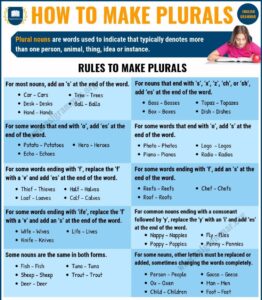Back to: English Language Primary 3
Welcome to class!
In today`s class, we shall be talking about the use of regular and irregular plurals in speaking and writing along with the use of auxiliary verbs. This topic covers the proper use of plural forms for nouns and the role of auxiliary verbs in constructing sentences.
Use of Regular and Irregular Plurals in Speaking and Writing
Today, we’ll dive into the world of plurals and auxiliary verbs. Just as architects select the right materials for a building, you’ll choose the correct plural form for nouns and employ auxiliary verbs effectively in sentences.
Regular Plurals:

Regular plurals follow a predictable pattern, usually adding “-s” to a noun to indicate more than one. For example: “ball” becomes “balls,” and “boy” becomes “boys.”
Irregular Plurals:

Irregular plurals don’t follow the standard pattern. Words like “child” become “children,” and “foot” becomes “feet.” These plurals require memorization.
Auxiliary Verbs:

Auxiliary verbs, such as “may,” “can,” and “will,” play a crucial role in constructing sentences. They help express permission, ability, and future actions.
Example Sentences:
Regular Plurals: “I have two balls to play with.”
Irregular Plurals: “Children love to play.”
Auxiliary Verbs: “I can swim in the pool.” Do you notice the words in bold? Those are examples of verbs.
I want you to practice creating sentences that incorporate both regular and irregular plurals, as well as auxiliary verbs. Can you do that? Great!
In today’s class, we discussed the use of regular and irregular plurals in speaking and writing” along with the use of auxiliary verbs, we explored the art of constructing sentences with precision. Regular plurals, formed by adding “-s” to nouns, and irregular plurals, which require memorization, were covered. Additionally, we delved into the role of auxiliary verbs like “may,” “can,” and “will” in expressing permission, ability, and future actions. Mastering these elements is essential for effective language construction, allowing us to communicate with clarity and accuracy.
Evaluation and Questions:
Why is it important to use the correct plural form for nouns and auxiliary verbs in sentences? Can you think of a sentence that combines regular and irregular plurals with an auxiliary verb?
Weekend Assignment
Over the weekend, construct sentences using a variety of regular and irregular plurals along with different auxiliary verbs. It’s like building language structures!
We have come to the end of today’s class. I hope you enjoyed the class!
In the next class, we shall be discussing how to express future action in the negative.
In case you require further assistance or have any questions, feel free to ask in the comment section below, and trust us to respond as soon as possible. Cheers!
